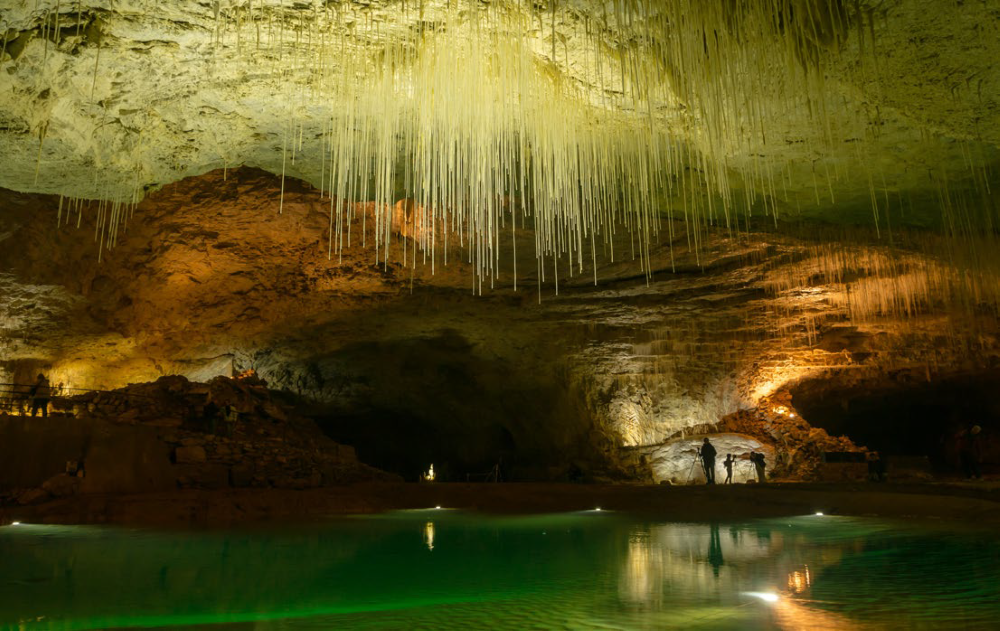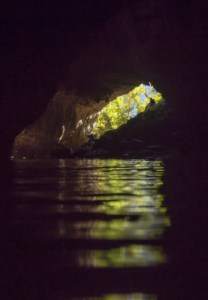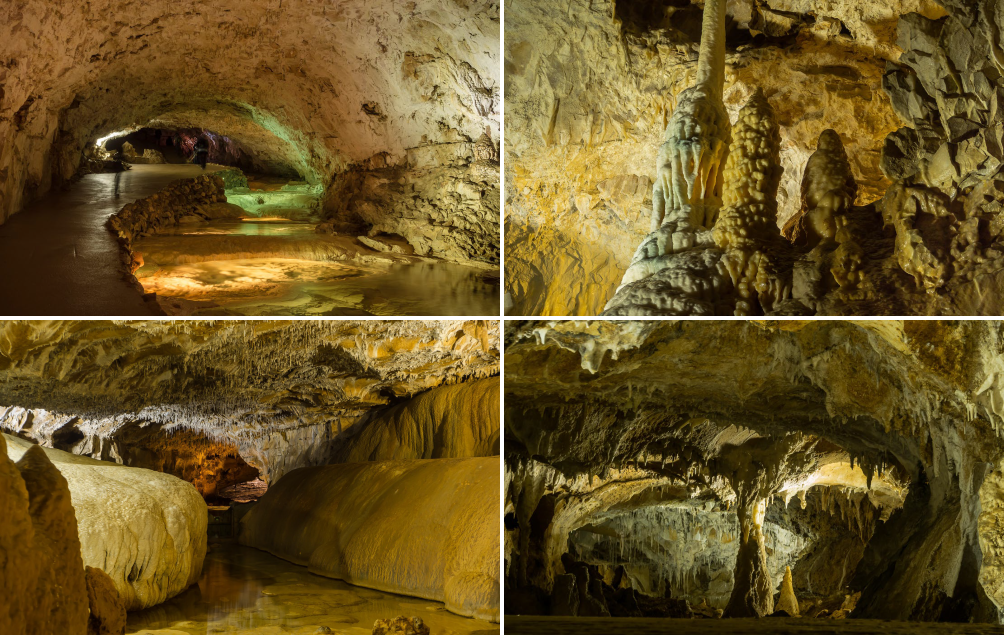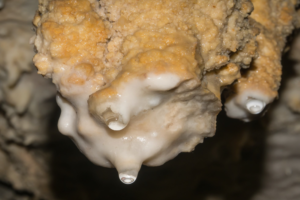
Typical for the cave of Choranche are the “ fistula“ that hang from the ceiling like straws . They are hollow inside and the water drips slowly and steadily out of them. Thus, the water level in the cave is almost consistently . A fistula grows about 5 cm in 100 years. For photographers, 3-4 times a year guided photo tours are offered .
The karst area of the Vercors Region is located in the foothills of the France-Alps, bounded on the East by Grenoble and on the West by Valence in the Rhone valley.
This location is an insiders’ tip where tourism has grown very slowly, barely industry, no congested roads, no large concrete tourist centers and just one small supermarket – a petit commerce.
Quiet and contemplative, characterized by marked crafts, agriculture and tourism. The region is known by scientists and mountaineers, hikers, base jumpers, speleologists, bat researchers and cave divers.
The access road in the territory enters into narrow gorges, where the restricted streets were partially knocked-off of the rock to form tunnels. Coming from the south via the little village of Die, serpentines lead up to the slopes of the plateau. Size restricted vehicles are only authorized to use this road. A mass tourism by buses is therefore excluded.
The Vercors, divided into two parts by the canyon of the river “La Bourne”, comprises an area of approximately 1.350 square kilometers: the North, which has opened up and developed for tourism has to offer all kinds of sporting activities – and the South, which is still wild and in its original purity.
In the early 70’s of the last century, the Vercors was declared as a regional natural preserve. As for flora and fauna, one will find alpine plants and animals that are eradicated elsewhere in Europe.
The plateaus and valleys provide habitat for eagles, various birds of prey and vultures, alpine ibex and marmots. More recently, lynx and wolves have also been resettled.
Alpine plants such as edelweiss, gentian and carline thistle occur there – but a special feature are the 60 species of orchids, of which the well known lady slipper’s orchid is only one to be mentioned.
The Vercors has to offer some 2000m mountains, of which the Mont Aiguille with 2086m is not the highest, but probably the best known, as it was the cradle of alpinism. In this region the alpine mountaineering was “invented” beginning of the 15th century by Charles VIII. At that time the mountain was conquered by ropes, hooks and ladders.
Even today, many hikers and climbers come to the region, which by its status as a nature park still shows a reasonably intact mountain scenery.

Cave entrance
Caves
Particularly impressive in this region is the subsoil with its natural attractions:
the numerous stalactite caves with their bizarre structures of calcium deposits.
Five caves have so far been made accessible to visitors:
- Grotte de Choranche
- Grotte de Thaïs
- Grotte de la Luire
- Cuves de Sassenage
- Scialet de Draye Blanche
How did the karst area in the Vercors and this stalactite formations develop ?
In the Mesozoic age, that was about 250 million years ago, when this area was still below sea level, reef limestone were formed and layers of marine deposits were created. This included snails, mussels and other marine life (now visible everywhere as fossils in the different rock layers).
In the Tertiary, that means 65 – 2 million years ago, rises and folds through tectonic processes have been produced by the pressure of the African plate on the Central Europe plate. Today this makes the aspect of the area, with more than 300m steep cliffs and drop-offs of the plateaus.
Rainwater, seeping away on the plateaus, have emerged the wonderful formations in the caves.
In a nutshell, this process can be explained like this: carbonated calcium is released from the limestone, caused by carbonic acid in the water – a corrosion takes place. More penetrating water leads to leaching of dissolved calcium carbonate, thereby forming large cavities in which water collects and flows.
At the same time, a reverse process takes place. The lime-saturated solution dripping down from the cave ceiling and leaving deposits on cave ceilings and floors, that is visible as stalactites and stalagmites after millions of year. The calcareous water forms gutters when flowing on the ground, some of them also have bizarre shapes. These wonderful and unique formations are serving as a magnet for visitors.

Bizarre beauties that have arisen in the course of millions of years . In the areas made available for day visitors an impressive LED lighting is used to highlight the natural beauty that is otherwise hidden in the darkness
The Cave of Choranche
As can be clearly seen on the 3D model in front of the cave of Choranche, the water runs off and only gets out above the ground when it strikes on a waterproof barrier. Until then, the water flows predominantly vertically through a 300 – 500m thick limestone layer. It is crystal clear filtered and has highest water quality.
The cave of Choranche was discovered in 1871, when in a dry period the inhabitants of Choranche were searching for the source of the river Gournier. Water came out of a gap in the rock. After having cleared away loose scree, the inhabitants found a narrow corridor which ended in a large hall with an subterranean sea. The two underground rivers “Le Coufin” and “Chevaline” flow together here. By the dry period, the access to this hall was released. Only 20 years later, the pioneer and speleologist Oscar Descombaz (*1866-+1914) explored the caves of Choranche – after the water level had dropped again by another dry period.
Today about 100,000 people per annum are visiting the cave of Choranche and explore the natural wonders on paved paths and under the supervision of the cave guides. The part opened for tourism is well-lighted and spectacularly staged, since 2013 , with modern LED technology.
The peculiarity of the “Grotte de Choranche” are the numerous thin fistula that hang from the ceiling like straws and grow only approximately 5 cm in 100 years. This fistula is due to the constant flow of water in the grotto, as the water descends slowly, but constant in these tubes. The longest of these fistulas has a length of 3.20m.
Stalactites and stalagmites are represented in different sizes and lengths, partly they are grown together over millions of years to large columns.
In the “cathedral”, an impressive space of about 50 x 80m, an enormous amount of “tambourines” arranged in cascades can be found, round gours into which the water drops steadily from the ceiling. The water accumulates to underground lakes, which flow out through gours – a bizarre world is formed.
Bournillon

Detail shots of stalactites and stalagmites.
The “Grotte de la Luire” at 45 km the longest cave system of the Vercors. At high water times, the level may rise up to 450 m in this transitional system. It drains into the “Grotte de Bournillon”, an impressive cave near Châtelus with a ceiling height of 140 m. The size of the cave opening is very impressive, especially the pink rocks of the vault that develops the largest cave in Europe.
Right “next door”, the highest waterfall in Europe with 320m height can be seen. The water rushes down from the semicircular cliffs of the “Cirque du Bournillon” and then merges with the water from the cave river.
Man has made his benefit with the amounts of water and the height of the cliffs: here a pumped storage power plant is incurred to generate electricity. Further down in the valley, the water is dammed again, the reservoir serves as a water supply in the area.
Fauna
In the part of the Bournillon cave, that is not accessible to the public, speleologists have found eyeless and non-pigmented crabs, catfish and other species. As eyes and pigmentation are not useful in a dark environment like a cave, other sensors such as antenna or barbels have been developed by evolution to scan the environment, and thus to perceive.
The symbolic animal for caves, the “Olm” (Proteus), is found in Choranche only tentatively in aquariums as it’s endemic only in the caves of the Balkans, what is now Slovenia. In other regions, these animals are not to be found, unless they are exhibited in aquariums. The pigmentless, about 35 cm large eyeless animals can be up to 60 years old. At birth, eyes are still present, but they wither away rather quickly and are later no longer recognizable.
The space over the water surface in the numerous caves is almost exclusively settled by bats, of which there exist about 30 species in the Vercors – an ideal retreat for light-shy animals. There are regular guided tours under the guidance of skilled specialists, participated by the tourists and school groups.
A recently discovered endemic insect in the caves of the Vercors is a species of longhorn beetles. However, there is still not much published.
Speleology – caving
Where it stops for day visitors in the caves, it begins for the speleologists, archaeologists and researchers: In the Choranche cave, which so far has researched plantthe most, a transitional system of 33 km in length has been explored. Scientists can penetrate within 6 – 8 hours. The only access is through the so-called “siphon”, a trap in an underwater cave part in the cave of Choranche. Passages, corridors and tubes lead to differently sized cavities with air bags in different levels. The exploration is still ongoing and will enhance the knowledge of this system. Any further attempt is recorded and documented in maps.
However, access is limited to keep the cave system in it’s natural shape, even for the “French Federation of Speleology” to 10 – 20 times per year.
Diving
Where water, rivers and lakes are present, we can do – of course – diving. One, who has found his niche in the large number of diving centers in France, is a native of the Vercors: William Thumy (www.vercors-plongee.com). His passion since earliest youth is cave-diving in the caves and crystal clear rivers of the Vercors. His diving center “Dive Xtreme” specializes in dives in caves, grottos, rivers and under ice with different levels of difficulty.
Even with the scientific explorations in the various caves, he is often involved and knows the latest state of the art
In the “Cave of Gournier” which is not far from the cave of Choranche, you can dive autonomously. Then, however, the equipment must be carried to the cave entrance. The water is consistently cold, about 8 – 10 ° C and crystal clear. A dry suit is highly recommended, but not necessary. Experiences in night diving and and a good buoyancy is a clear advantage.
In the huge cave, where the water is 3 – 5 m deep, you can see stalagmites on the floor and there are the stalactites fallen from the cave ceiling. The walls have the structures of calcium deposits that are usual for caves – a sign that the water level must have been much higher even over long periods. The particular pride is the “méduse” on the wall, a stalactite formation in jellyfish shape and a real eye-catcher. To the rear end, where the underground river comes from, the cave becomes more and more narrow and the ceiling is becoming increasingly flatter – there is a slight current towards the cave exit. On the back wall you can see a sort of gutter and sinter pools, through which the water drained in former times. Normally, the water is crystal clear, if not previously some divers have plowed through the cave and have stirred up the sediment. Through the constant light flow of incoming water, the suspended particles are transported towards the cave exit and after a short time, the visibility is good again.
Not to be underestimated are the lighting conditions that are comparable to a night dive. Although light is incident from the cave entrance and the walls are bright, the light is swallowed by the huge size of the cave of Gournier and in the water nothing remains. Good torches are recommended!
The Gournier is considered the most beautiful underground river of the world. Its course can track up to 15 km. Again and again, galleries open with waterfalls and pools, connected by gours and gutters. With ropes, ladders and hooks, the scientists have now penetrated deeper and deeper. Some videos can be seen on YouTube in the internet.
Barnabé Fourgous, a french scientist, has found the fossilized skeleton of a bear that extinct more than thirty thousand years ago. Due to the conditions in the cave, the skeleton is very well preserved. In some parts of the cave system you can also find evidence of prehistoric people.

On the left
When cave diving in the “Grotte du Gournier“ water drain gutters can clearly be seen, originating from earlier times . Here, the water level must have been significantly lower some million years before.
On the right
Photographer : William Thumy who with his diving center “Dive Xtreme“ is pecializing in caves and cave diving, river diving and ice diving he takes with its base a special position . For diving in the underground passages , however, it requires a special training.
More specifically it is with diving into the water-bearing passages themselves. To do so, one must have previous experience in cave diving and the appropriate training. Not everyone is allowed to dive inside and if, only under leadership. Here again, William Thumy is the right partner for divers who want to undertake this adventure.
From narrow water-filled tunnels to spacious rooms with air bags and more, the cavities are always connected by underground rivers and tunnels – fearless can dive an unique wonderland and admire the bizarre lime structures underwater. Technical equipment is required – here you should ask in advance, what requirements are imposed.
Based on the section of the “Grotte de Thaïs” (created by Yves Billaud) you can clearly see the difficulties in extreme cave diving: the road is long and partially narrow – the return trip must be counted in. As the previously explored part has a difference in altitude of about 90m, an advanced decompression procedure is required.
Most times, only the scientists can be found in the caves to study, explore and document and go even deeper into the various caves. All scientific studies are coordinated by EDYTEM (Environnements, Dynamiques et Territoires de la Montagne – environment, dynamics and territories of the Mountain), an association of the CNRS (Centre national de la recherche scientifique – national center for scientific research) and the University of Savoi, consisting of speleologists, pre-historians, geologists and geographers.
People in the Vercors region
It is documented by artefacts of human remains from prehistoric age, that the region is known to the mankind for a long time. The caves offered protection against the cold and water was available in abundance. There were also animals such as deer and ibex, which could be hunted. Marmots served as fat and fur supplier. However, proof of real settlement is found rather in the deeper parts of the Vercors.
During the 2nd world war, the Vercors served as a refuge for the people from the Resistance. Some medieval castles have been irrevocably destroyed during that phase.
Today’s villages in the Vercors region have a more rural character with no big supermarkets but lots of small shops where you can buy the products of the region: goat cheese, dairy products, walnut products and handicrafts. Hotels are reasonable small and personal, accommodations can be found on many isolated lying farms.
Still today you can find evidence, like in Pont-en-Royans, that man has come to terms with the water and has made it for himself a benefit. The tiny village Pont-en-Royans was one of the first places in France, which had its own power supply. Until the 60’s, parts for electric installations were produced in this village. In the “Museum of water”, you can have a look at the entire history concerning the water.

The picturesque setting of hung on the rock houses in Pont-en-Royans , the “ entrance “ to the northern Vercors . People here havealways lived with the water and made their benefit with the water.
WORDS and PICTURES by Claudia Weber-Gebert

















